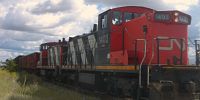Rick Karr, Blueprint America correspondent
The town where I grew up – Highland, IN – was criss-crossed by freight rail lines. A two-track right-of-way ran not more than a hundred yards from my house; the same lines ran past the high school. Another line bisects the downtown area. And one of Canadian National’s (CN) main lines cuts across the southern edge of town.
So I have a little experience with the issues Blueprint America covers in our most recent story for The NewsHour with Jim Lehrer. I know what it means to wait with the engine turned off while a freight train crawls by. I also know that certain communities are more likely than others to bear that burden.
Highland was pretty lucky: The neighboring town, Griffith, was the site of one of the busiest railroad junctions in the country. The downtown area of the nearby city of Hammond, where my father grew up, was frequently boxed in by trains waiting to clear a junction there. The joke was that if you’d lived in Hammond for 20 years, you’d spent a decade waiting for trains.
Hammond and Griffith, with all of their trains, were seen as less-desirable places to live; their per-capita incomes and property values were lower than Highland’s. People didn’t want to live near that many trains. So I can, in a sense, understand why people in Barrington, IL – home one of the wealthiest ZIP codes in Illinois – have been howling in protest ever since Canadian National decided to re-route a couple dozen trains a day from its mainline to a belt line that it purchased last year. As a University of Chicago study pointed out, the shift in train traffic is likely to impact wealthier communities while easing the burden on poorer towns – like Griffith, IN; South Holland, IL; and Chicago’s troubled South Side.
Canadian National has good reasons to make the change. As we reported in our last piece for the NewsHour, freight trains move through Chicago – one of the nation’s worst freight bottlenecks – at an average of nine miles an hour. And while the City of Chicago, railroads, and federal authorities have developed a plan to ease that congestion, it won’t be complete for years. So CN moved to do what it could now.
The railroad didn’t have many options. Notice that when I wrote about Highland, above, I wrote about some of the train lines in past tense. That’s because a lot about the railroads has changed in the Chicago area. The lines that ran past my house and Highland High School have been removed and turned into a rails-to-trails parkway. Dozens of other tracks have been abandoned. That’s part of a national trend: Track mileage in the U.S. peaked before the Great Depression, and has declined ever since. Railroads and communities have also invested in infrastructure to separate road and rail traffic – that’s what happened in downtown Hammond, for example. So fewer Americans today are waiting for freight trains to pass.
Of course, that’s on average. The re-routing will be tough on folks in Barrington – and the 32 other towns along the line that will see more trains. Some anti-CN activists are saying that the traffic problems are already worse than the railroad is telling federal regulators (CN says its reports to Washington are accurate). The towns want infrastructure to keep road and rail traffic out of one another’s ways – bridges over tracks, or underpasses beneath them.
Some municipalities – like Griffith, right next to my home town – negotiated settlements with CN, usually for less than 10 percent of the cost of new infrastructure (The rest will be paid by taxpayers). Two municipalities – Lynwood and Aurora, both in Illinois – got something better: Regulators at the Surface Transportation Board (STB) ordered CN to pay the bulk of the cost of new bridges or underpasses. As we report, CN has gone to court to overturn those orders, arguing that railroads traditionally pay no more than 10 percent of infrastructure costs because new “grade separations” primarily benefit highway users – so highway users (i.e. taxpayers) should bear the brunt of the cost.
Then there are municipalities like Barrington, which got neither a negotiated settlement nor a federal order. Members of the STB thought that was a raw deal: One thought the Board should have set a higher bar when considering CN’s request, while another urged the board to pay more attention to community concerns. Nonetheless, board members couldn’t find consensus – the board’s mandate, after all, is primarily to ensure that railroads remain competitive – and didn’t order CN to pay for more infrastructure.
Some members of Congress want to make sure that doesn’t happen again. House Transportation and Infrastructure committee Chairman James Oberstar (D-MN) sponsored a bill last year to force the STB to pay closer attention to community needs (Rep. Pete Visclosky [D-IN], who represents my home town, was a co-sponsor). The bill failed in committee, but Oberstar’s staff says he’s likely to introduce it again this year – even though it’ll be too late to prevent a similar change in rail routing from affecting his own district.



